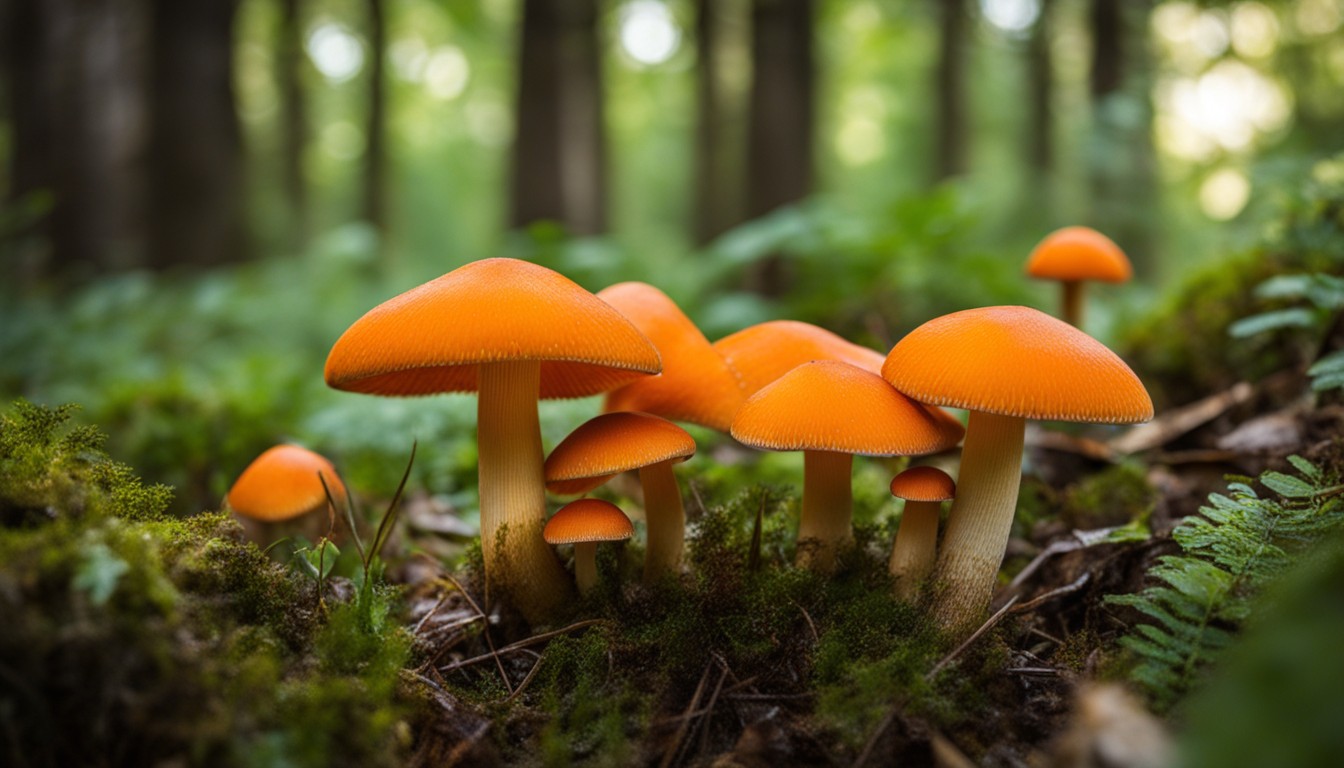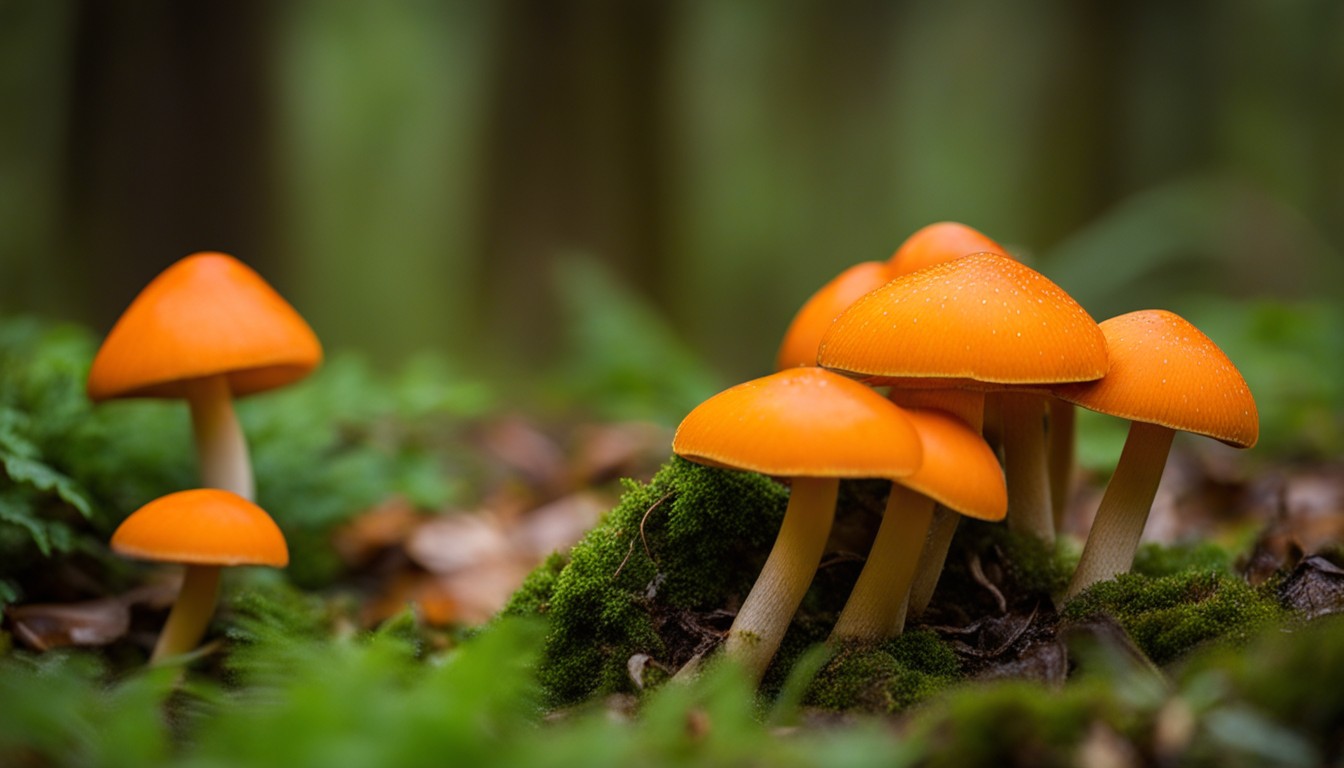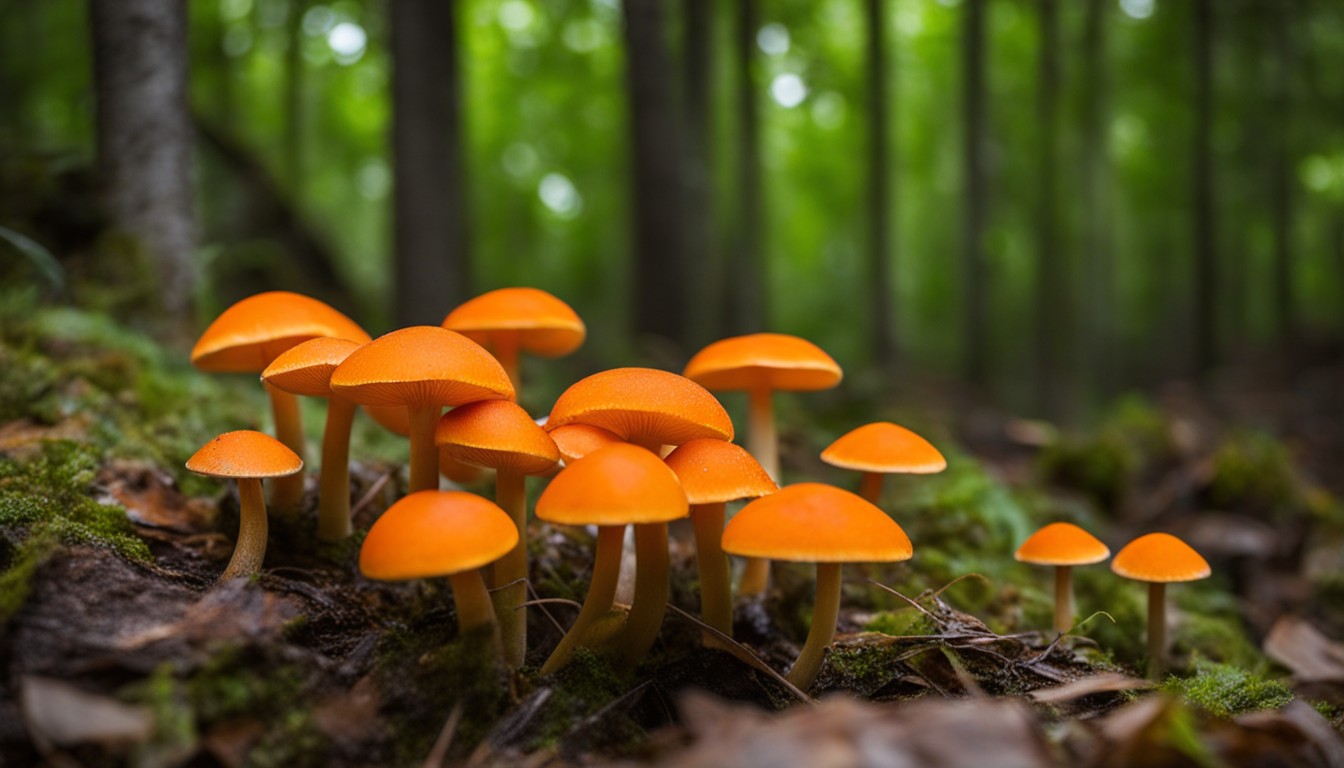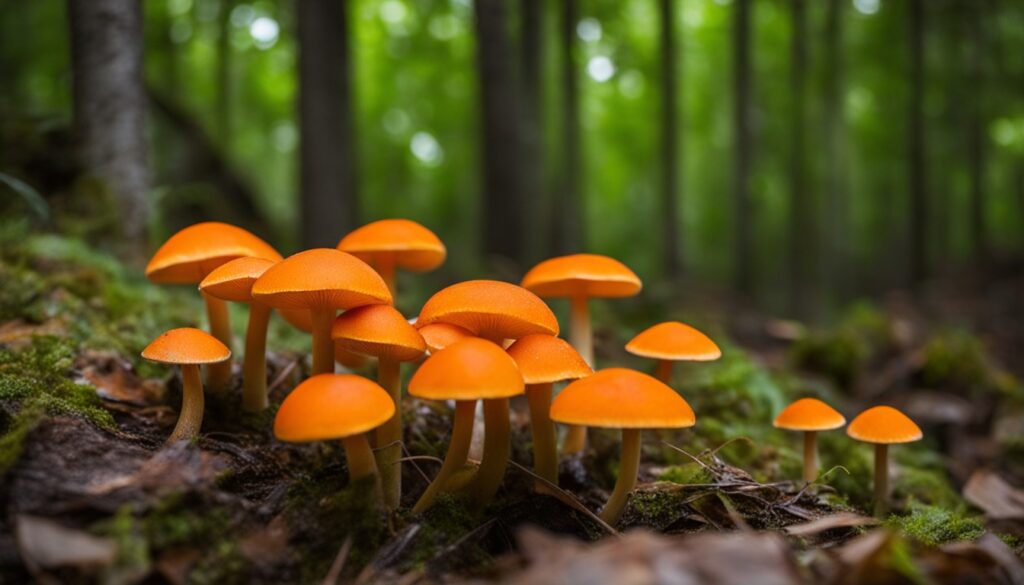Orange mushrooms are a common sight in Pennsylvania’s forests, and identifying them can be an intriguing and rewarding endeavor. This comprehensive guide aims to equip nature enthusiasts with the knowledge needed to identify and appreciate the diverse array of orange mushrooms found throughout the state. From distinctive features to habitat preferences, this article explores the fascinating world of orange mushrooms and encourages readers to delve into the captivating realm of local fungi. Whether you’re a beginner or an experienced mushroom hunter, this guide will help you confidently identify and appreciate the wonders of orange mushrooms in Pennsylvania.
Understanding Local Fungi in Pennsylvania
Penetrating the enigmatic world of local fungi successfully means appreciating the intricate biodiversity of Pennsylvania’s mushrooms. These fungi are not merely components of our environment, but dynamic players in a vast, interconnected ecosystem.
Understanding this critical realm of Pennsylvania’s biodiversity is more than just a scientific endeavor. It connects us to our local environment, reminding us of the unexpected yet vital roles that these often overlooked organisms play within our ecosystems.
What are Fungi?
Fungi, a distinct biological kingdom, serve an essential role in nature, acting as critical decomposers that help recycle organic matter. Unlike plants, they can’t photosynthesize, deriving nutrients instead from decomposing organic material.
In ecosystems, fungi serve as essential decomposers, breaking down organic matter into nutrients, enriching the soil, and forming symbiotic relationships with plants to aid nutrient uptake.
Fungi exist in vast varieties, from simple single-celled yeast, to complex multicellular mushrooms. Often, the visible mushroom is just a small portion of the overall organism, most of which is a hidden network of threads or hyphae in the soil.
The life-cycle of fungi is a fascinating process. They reproduce either sexually or asexually through releasing spores, tiny cells that can grow into a new organism. These spores disperse in the environment and germinate under suitable conditions.
Fungi function as nature’s recyclers, breaking down dead organic matter and converting it into nutrients. In doing so, they enrich the soil, contributing to the health of ecosystems. Some fungi also form symbiotic relationships with plants, aiding nutrient uptake.
Importance of Identifying Mushrooms
Unintentional consumption of misidentified mushrooms can result in severe health consequences, highlighting the critical importance of accurate identification. Preventive measures involve educating oneself about local fungi, seeking expert guidance, and exercising caution before consumption.
In Pennsylvania, systematic identification of mushrooms, notably orange mushrooms, contributes significantly to understanding local biodiversity. This knowledge aids in ecological conservation efforts while ensuring safety during mushroom foraging endeavors.
Ecology of Orange Mushrooms
In the natural world, orange mushrooms play a pivotal role. These unique organisms flourish in an ecological niche grounded in decomposing organic matter, providing critical input into nutrient cycling processes.
The terrain of Pennsylvania, rich in forests and moist, humus-filled soil, caters exceptionally well to the growth of these vibrant fungi, creating a symbiosis with the surrounding flora.
Indeed, orange mushrooms have a synergistic relationship within their ecosystem. Various trees and shrubs benefit directly from these fungi, miniature powerhouses that channel nutrients from the environment into the roots of the plants they nurture.
The reciprocity extends to animal life as well. Certain species of insects and small mammals rely on these fungi for food and even habitat, suggesting a complex and interwoven ecological web surrounding these organisms.
In essence, the existence and proliferation of orange mushrooms indicate a thriving ecosystem, as they assist in decomposition, nourish vegetation, and support various forms of wildlife while beautifying Pennsylvania’s rich landscapes.
Common Orange Mushrooms in Pennsylvania
Pennsylvania’s mycological landscape is liberally sprinkled with a variety of orange mushrooms, including species like Armillaria tabescens, commonly known as the ‘Ringless Honey Mushroom’, and Hygrocybe miniata, or the ‘Scarlet Waxcap. Familiarity with these common mushrooms aids in accurate identification.
A deep dive into the mycological world reveals a vast spectrum of orange fungi in Pennsylvania – from the brightly colored Jack-o’-lantern mushroom to the subtler hues of the Apricot Jelly Mushroom. This exploration is instrumental in understanding local biodiversity and crucial for safe and mindful foraging.
Physical Characteristics of Orange Mushrooms

Orange mushrooms, native to Pennsylvania, boast unique physical traits that facilitate identification. These characteristics range from cap shape, color intensity and texture, to stem thickness and presence of a veil.
- Distinct cap shapes ranging from convex to flat or bell-shaped.
- Variation in color intensity, from vibrant to pale orange.
- Diverse cap textures, either smooth, scaly, or striated.
- Stem thickness and length, varying widely among species.
- Presence or absence of a veil, influencing the mushroom’s overall appearance.
Habitat and Growing Conditions
In Pennsylvania’s diverse ecosystems, ideal growing conditions for orange mushrooms often include shady, moist areas with abundant organic matter present.
- Vegetation and dead wood in forests and woodlands
- Leaf litter in deciduous woodland floors
- The shaded regions of gardens and parks
- Riverbanks and damp areas near water bodies
- Soil rich in organic matter
Identifying Orange Mushrooms

For those passionate about mycology, the mastery of mushroom identification is essential and intriguing, particularly in the context of orange fungi found prolifically in Pennsylvania. This dedicated guide hones in on these orange marvels, giving users slight and significant traits to look out for.
Pennsylvania boasts a rich array of mycological intrigue, notably the various species of orange mushrooms. The identification of these local flavors of fungi is best approached systematically, capturing a comprehensive understanding of their unique characteristics and variances.
Examining Cap and Stem
In the exploration of Pennsylvania’s orange fungi, both the cap and stem structures play crucial roles in proper identification. Their shapes, sizes, and colors can point out the exact species of mushroom, making them distinguishing features for mushroom foragers.
- Thickness and height of stem
- Surface texture of the cap and stem
- Presence or absence of a ring on the stem (annulus)
- Shape and color of the cap and stem
- Attachment of cap to the stem
- Condition of stem base: Bulbous, club-shaped, equal, or tapering
Looking at Gills or Pores
Observing gills or pores serves as an essential part of identifying orange mushrooms in Pennsylvania. The specific features of these structures provide significant aid to differentiate among various species.
- Surface color of the gills or pores
- Spacing between the gills
- Attachment of gills to the stem (free, attached, decurrent)
- Gill thickness and edge details
- Presence of a pore surface instead of gills on the underside of the cap
- Color changes in gills or pores when bruised
Noting Odor and Spore Color
An important step in identifying orange mushrooms in Pennsylvania is noting their scent and spore color. These characteristics are valuable tools for mushroom identification as they can provide clues about the species.
- Assess the odor of the mushroom. Some species give off distinctive smells; sweet, sour, or no smell at all.
- Gather spore samples for color identification. Use a spore print activity to get this color.
- Compare these characteristics with a field guide or mushroom identification app for accurate results.
Using a Field Guide or App
Field guides and apps dedicated to identifying local fungi offer invaluable benefits, providing detailed insights into the complex world of Pennsylvania’s native orange mushrooms. These resources, complete with copious visual references and descriptive information, assist in more precise identification.
Leveraging digital tools can significantly enhance the accuracy when identifying local fungi. Tools often come equipped with functions such as image recognition and detailed databases, enabling the user to eliminate potential identification errors and misclassifications.
Learning from real-world experiences, these guides and digital applications can support the mushroom forager in evolving their knowledge base, honing their identification skills, and fostering a deeper appreciation for the intricacies of Pennsylvania’s extensive fungal diversity.
Potential Dangers and Toxicity

The potential hazards and toxicity levels of misidentified orange mushrooms unveil a crucial aspect of mycology. Consuming a mistakenly identified poisonous mushroom can lead to serious health consequences, even death.
Comprehending the threats posed by toxic orange mushrooms in Pennsylvania, both to human health and the ecosystem, is vital. It not only enhances safety but also contributes to responsible foraging and biodiversity conservation practices.
The Risks of Misidentification
Venturing into the identification of orange mushrooms holds a discreet pang of danger, as misidentification can lead to unwanted outcomes. The ingestion of incorrectly identified fungi could cause harm, with symptoms ranging from mild stomach upsets to life-threatening conditions.
Despite their allure, orange mushrooms weave an intricate tapestry of potential peril. Mistaking toxic varieties like the deadly Galerina for edible companions poses grave risks. Misidentified fungi can mimic benign species, becoming common pitfalls for amateur mycologists and foragers alike.
Toxic Orange Mushrooms to Avoid
Toxic orange mushrooms are no rarity in Pennsylvania. Especially avoid Deadly Galerina, Conocybe Tenera, and Fly Agaric which carry damaging toxins.
The Deadly Galerina, recognized by it’s domed cap and gilled underside, poses a poisonous threat. It carries deadly amatoxins, causing severe liver damage and sometimes death.
Similarly, Conocybe Tenera, with its petite, cone-shaped, dull orange cap, is another fatal mushroom. It also contains amatoxins, leading to catastrophic liver and kidney injuries.
Visually striking in its bright, variably orange-red cap with white spots, the Fly Agaric, while not typically deadly, can cause severe, disorienting psychoactive effects.
A responsible mushroom enthusiast should consult pictorial directories and field guides for accurate identification. Thus, avoiding harmful encounters with these toxic species.
Contacting Local Mycologists for Help
To bolster your mycological knowledge and reduce risks, contacting Pennsylvania’s local mycologists can be exceptionally beneficial. Their expertise can provide precise identification and valuable insights about the local fungal diversity.
Inquiring local mycologists can be a crucial step for mushroom identification. They can verify your findings, offering safety and peace of mind, especially when dealing with potentially toxic species.
When reaching out to professional mycologists, have detailed photographs and clear descriptions of the mushroom’s characteristics. This best practice would streamline the identification process, making it both efficient and accurate.
Conservation and Mushroom Foraging
Sustainable foraging is key to maintaining the diversity of Pennsylvania’s orange fungi. It takes into account the overall health of the ecosystem, prioritizing fungi’s natural role within it. It’s more than foraging; it’s about nurturing biodiversity.
Notwithstanding the pleasure of collecting edible fungi, it’s crucial to monitor our foraging activities. Unsustainable practices could threaten Pennsylvania’s diverse orange fungi, depleting them beyond recovery. Conservation, then, is not merely for the fungi but for the overall health of our woodland ecosystems.
Responsible Mushroom Foraging
A sustainable approach to mushroom foraging in Pennsylvania is vital. Stripping the landscape bare threatens the sustainability of orange mushroom populations and harms the overall ecosystem.
Understanding the impact of excessive foraging on the local orange mushroom population is a mark of responsibility. Over-collection can lead to scarcity, affecting the balance within local ecosystems.
Foraging responsibly is not limited to restraint in collection. Checking mushroom maturity before picking ensures younger ones continue to thrive, promoting population growth.
Respect for rules and regulations set by local authorities also plays into responsible foraging. Most parks regulate mushroom hunting to ensure biological diversity is maintained.
Ultimately, a responsible forager sees themselves as part of a larger ecosystem. The aim should be to preserve and contribute to the health of this ecosystem, not exploit it for personal gain.
The Role of Orange Mushrooms in Ecosystems
As indispensable ecosystem engineers, orange mushrooms contribute massively to Pennsylvania’s bio-network. They facilitate nutrient breakdown and exchange, fostering healthier and more biodiverse habitats.
Orange mushrooms serve as keystone actors within Pennsylvania’s ecosystems. With their role in decomposing organic matter and promoting soil fertility, they significantly affect the survival of other flora and fauna in their environment.
FAQ: Orange Mushrooms in Pennsylvania: A Guide to Identifying Local Fungi
What is the ecological importance of orange mushrooms in Pennsylvania?
Orange mushrooms play a vital role in Pennsylvania’s ecosystems as decomposers, breaking down organic matter and recycling nutrients back into the environment. They also form beneficial symbiotic relationships with trees, aiding in nutrient absorption.
Why is accurate identification of orange mushrooms important?
Accurate identification of orange mushrooms is crucial to ensure responsible foraging and to avoid consuming poisonous species. It also helps contribute to scientific knowledge and understanding of local fungal diversity.
How can I accurately identify orange mushrooms in Pennsylvania?
To accurately identify orange mushrooms, pay attention to distinctive features such as color, shape, texture, and the presence of gills, pores, or spines. Use field guides, online resources, and expert assistance to enhance your identification skills.
What precautions should I take when foraging orange mushrooms?
When foraging orange mushrooms, it is essential to follow responsible practices. Only collect mushrooms you can confidently identify as safe and edible. Avoid collecting rare or protected species, and be mindful of the habitats you are exploring, leaving no trace of your presence.
Can I eat orange mushrooms I find in Pennsylvania?
While some orange mushrooms are edible and prized for their culinary value, others can be toxic or even deadly. It is crucial to exercise extreme caution and consult with experienced foragers or mycologists before consuming any wild mushrooms.
What resources and organizations can help me learn more about orange mushrooms in Pennsylvania?
There are various resources available to expand your knowledge of orange mushrooms in Pennsylvania. Local mycological societies, nature centers, and online forums provide opportunities for learning and connecting with fellow enthusiasts. Additionally, reputable field guides and online databases can assist in mushroom identification.
Conclusion
Understanding and conserving Pennsylvania’s local fungi is crucial, particularly the varied orange mushrooms. Paying due attention to physical traits, habitats, and precautionary measures during identification can help us appreciate and sustain these fungi in our ecosystems.
To safeguard the future of orange mushrooms in Pennsylvania, adopting sustainable practices, such as responsible foraging and seeking help from local mycologists when in doubt, is vital. Ensuring correct identification prevents disruption of the ecosystem caused by poisonous species.
- Remember to examine cap and stem, note the odor and spore color, and look at gills or pores when identifying.
- Use field guides or identification apps for accurate results.
- Abstain from harmful over-foraging and engage in responsible mushroom picking.
- Avoid toxic mushrooms and consult local mycologists when unsure.
- Understand the significant role of orange mushrooms in local ecosystems.

